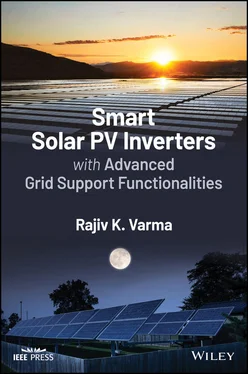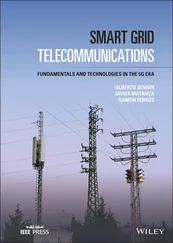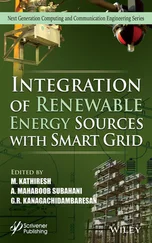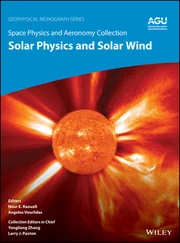Rajiv K. Varma - Smart Solar PV Inverters with Advanced Grid Support Functionalities
Здесь есть возможность читать онлайн «Rajiv K. Varma - Smart Solar PV Inverters with Advanced Grid Support Functionalities» — ознакомительный отрывок электронной книги совершенно бесплатно, а после прочтения отрывка купить полную версию. В некоторых случаях можно слушать аудио, скачать через торрент в формате fb2 и присутствует краткое содержание. Жанр: unrecognised, на английском языке. Описание произведения, (предисловие) а так же отзывы посетителей доступны на портале библиотеки ЛибКат.
- Название:Smart Solar PV Inverters with Advanced Grid Support Functionalities
- Автор:
- Жанр:
- Год:неизвестен
- ISBN:нет данных
- Рейтинг книги:3 / 5. Голосов: 1
-
Избранное:Добавить в избранное
- Отзывы:
-
Ваша оценка:
- 60
- 1
- 2
- 3
- 4
- 5
Smart Solar PV Inverters with Advanced Grid Support Functionalities: краткое содержание, описание и аннотация
Предлагаем к чтению аннотацию, описание, краткое содержание или предисловие (зависит от того, что написал сам автор книги «Smart Solar PV Inverters with Advanced Grid Support Functionalities»). Если вы не нашли необходимую информацию о книге — напишите в комментариях, мы постараемся отыскать её.
Smart Solar PV Inverters with Advanced Grid Support Functionalities
Smart Solar PV Inverters with Advanced Grid Support Functionalities’
Smart Solar PV Inverters with Advanced Grid Support Functionalities — читать онлайн ознакомительный отрывок
Ниже представлен текст книги, разбитый по страницам. Система сохранения места последней прочитанной страницы, позволяет с удобством читать онлайн бесплатно книгу «Smart Solar PV Inverters with Advanced Grid Support Functionalities», без необходимости каждый раз заново искать на чём Вы остановились. Поставьте закладку, и сможете в любой момент перейти на страницу, на которой закончили чтение.
Интервал:
Закладка:
Table of Contents
1 COVER
2 SERIES PAGE IEEE Press 445 Hoes Lane Piscataway, NJ 08854 IEEE Press Editorial Board Ekram Hossain, Editor in Chief Jón Atli Benediktsson Xiaoou Li Jeffrey Reed Anjan Bose Lian Yong Diomidis Spinellis David Alan Grier Andreas Molisch Sarah Spurgeon Elya B. Joffe Saeid Nahavandi Ahmet Murat Tekalp
3 TITLE PAGE
4 COPYRIGHT PAGE
5 DEDICATION PAGE
6 ABOUT THE AUTHOR
7 FOREWORD
8 PREFACE
9 ACKNOWLEDGMENTS
10 LIST OF ABBREVIATIONS
11 1 IMPACTS OF HIGH PENETRATION OF SOLAR PV SYSTEMS AND SMART INVERTERDEVELOPMENTS 1.1 Concepts of Reactive and Active Power Control 1.2 Challenges of High Penetration of Solar PV Systems 1.3 Development of Smart Inverters 1.4 Conclusions References
12 2 SMART INVERTER FUNCTIONS 2.1 Capability Characteristics of Distributed Energy Resource (DER) 2.2 General Considerations in Implementation of Smart Inverter Functions 2.3 Smart Inverter Functions for Reactive Power and Voltage Control 2.4 Smart Inverter Function for Voltage and Active Power Control 2.5 Low/High Voltage Ride‐Through (L/H VRT) Function 2.6 Frequency–Watt Function 2.7 Low/High Frequency Ride‐Through (L/H FRT) Function 2.8 Ramp Rate 2.9 Fast Frequency Response 2.10 Smart Inverter Functions Related to DERs Based on Energy Storage Systems 2.11 Limit Maximum Active Power Function 2.12 Set Active Power Mode 2.13 Active Power Smoothing Mode 2.14 Active Power Following Function 2.15 Prioritization of Different Functions 2.16 Emerging Functions 2.17 Summary References
13 3 MODELING AND CONTROL OF THREE‐PHASE SMART PV INVERTERS 3.1 Power Flow from a Smart Inverter System 3.2 Smart PV Inverter System 3.3 Power Circuit Constituents of Smart Inverter System 3.4 Control Circuit Constituents of Smart Inverter System 3.5 Smart Inverter Voltage Controllers 3.6 PV Plant Control 3.7 Modeling Guidelines 3.8 Summary References
14 4 PV‐STATCOM: A NEW SMART PV INVERTER AND A NEW FACTS CONTRO 4.1 Flexible AC Transmission System (FACTS) 4.2 Static Var Compensator (SVC) 4.3 Synchronous Condenser 4.4 Static Synchronous Compensator (STATCOM) 4.5 Control Modes of SVC and STATCOM 4.6 Photovoltaic‐Static Synchronous Compensator (PV‐STATCOM) 4.7 Operating Modes of PV‐STATCOM 4.8 Functions of PV‐STATCOM 4.9 Cost of Transforming an Existing Solar PV System into PV‐STATCOM 4.10 Cost of Operating a PV‐STATCOM 4.11 Summary References
15 5 PV‐STATCOM APPLICATIONS IN DISTRIBUTION SYSTEMS 5.1 Nighttime Application of PV Solar Farm as STATCOM to Regulate Grid Voltage 5.2 Increasing Wind Farm Connectivity with PV‐STATCOM 5.3 Dynamic Voltage Control by PV‐STATCOM 5.4 Enhancement of Solar Farm Connectivity by PV‐STATCOM 5.5 Reduction of Line Losses by PV‐STATCOM 5.6 Stabilization of a Remotely Located Critical Motor by PV‐STATCOM 5.7 Conclusions References
16 6 PV‐STATCOM APPLICATIONS IN TRANSMISSION SYSTEMS 6.1 Increasing Power Transmission Capacity by PV‐STATCOM 6.2 Power Oscillation Damping by PV‐STATCOM 6.3 Power Oscillation Damping with Combined Active and Reactive Power Modulation Control of PV‐STATCOM 6.4 Mitigation of Subsynchronous Resonance (SSR) in Synchronous Generator by PV‐STATCOM 6.5 Alleviation of Subsynchronous Oscillations (SSOs) in Induction‐Generator‐Based Wind Farm by PV‐STATCOM 6.6 Mitigation of Fault‐Induced Delayed Voltage Recovery (FIDVR) by PV‐STATCOM 6.7 Simultaneous Fast Frequency Control and Power Oscillation Damping by PV‐STATCOM 6.8 Conclusions References
17 7 INCREASING HOSTING CAPACITY BY SMART INVERTERS – CONCEPTS AND APPLICATIONS 7.1 Hosting Capacity of Distribution Feeders 7.2 Hosting Capacity Based on Voltage Violations 7.3 Increasing Hosting Capacity with Non Smart Inverter Techniques 7.4 Characteristics of Different Smart Inverter Functions 7.5 Factors Affecting Hosting Capacity of Distribution Feeders 7.6 Determination of Settings of Constant Power Factor Function 7.7 Impact of DER Interconnection Transformer 7.8 Determination of Smart Inverter Function Settings from Quasi‐Static Time‐Series (QSTS) Analysis 7.9 Guidelines for Selection of Smart Inverter Settings 7.10 Determination of Sites for Implementing DERs with Smart Inverter Functions 7.11 Mitigation Methods for Increasing Hosting Capacity 7.12 Increasing Hosting Capacity in Thermally Constrained Distribution Networks 7.13 Utility Simulation Studies of Smart Inverters for Increasing Hosting Capacity 7.14 Field Implementation of Smart Inverters for Increasing Hosting Capacity 7.15 Conclusions References
18 8 CONTROL COORDINATION OF SMART PV INVERTERS 8.1 Concepts of Control Coordination 8.2 Coordination of Smart Inverters with Conventional Voltage Controllers 8.3 Control Interactions – Lessons Learned from Coordination of FACTS Controllers for Voltage Control 8.4 Control Interactions Among Smart PV Inverters and their Mitigation 8.5 Study of Smart Inverter Controller Interactions 8.6 Case Study of Controller Coordination of Smart Inverters in a Realistic Distribution System 8.7 Control Coordination of PV‐STATCOM and DFIG Wind Farm for Mitigation of Subsynchronous Oscillations 8.8 Control Interactions Among Plants of Inverter Based Resources and FACTS/HVDC Controllers 8.9 Conclusions References
19 9 EMERGING TRENDS WITH SMART SOLAR PV INVERTERS 9.1 Combination of Smart PV Inverters with Battery Energy Storage Systems (BESS) 9.2 Combination of Smart PV Inverters with Electric Vehicle Charging Systems 9.3 Combination of Smart PV Inverters with Battery Energy Storage Systems (BESS) and EV Charging Systems 9.4 Grid Forming Inverter Technology 9.5 Field Demonstrations of Smart Solar PV Inverters 9.6 Potential of New Revenue Making Opportunities for Smart Solar PV Inverters 9.7 Conclusions References
20 INDEX
21 END USER LICENSE AGREEMENT
List of Tables
1 Chapter 1 Table 1.1 Impact of PV penetration on damping of critical mode.
2 Chapter 2 Table 2.1 Minimum reactive power injection and absorption capability. Table 2.2 Default volt–var settings for different international standards. Table 2.3 International default volt–watt settings normalized to ANSI volta...
3 Chapter 4Table 4.1 Cost of a 5 MW utility‐scale single‐axis tracker PV system with e...Table 4.2 Cost of a 100 MW utility‐scale single‐axis tracker PV system with...Table 4.3 Costs of STATCOMs and SVCs.
4 Chapter 5Table 5.1 Increase in capacity of wind farm.Table 5.2 System losses and additional loss reduction for Scenario 1.Table 5.3 Summary of energy savings for different cases.
5 Chapter 6Table 6.1 Increase in stable power transfer limit (MW) for study system I w...Table 6.2 Increase in power transfer limits for study system II with differ...Table 6.3 Settling time of power oscillations with different PV‐STATCOM loc...Table 6.4 Comparison of performance of controller with and without TOV supp...
6 Chapter 7Table 7.1 Different methods of determining settings of smart inverter funct...Table 7.2 Calculation of PV site impact factor.Table 7.3 Coordinates of volt–var function.Table 7.4 International default settings of volt‐watt function normalized t...Table 7.5 International default settings of volt‐var function normalized to...Table 7.6 Settings of watt‐power factor.Table 7.7 Settings of fixed power factor.
7 Chapter 8Table 8.1 Increase in hosting capacity obtained from different smart grid (...Table 8.2 System eigenvalues for different cases.
8 Chapter 9Table 9.1 Minimum voltages at selected junction points before and after EV ...
List of Illustrations
1 Chapter 1 Figure 1.1 A simple power system with an inductor connected at PCC. Figure 1.2 Phasor diagrams for network with inductive load; (a) network with... Figure 1.3 A simple power system with a capacitor connected at PCC.
Читать дальшеИнтервал:
Закладка:
Похожие книги на «Smart Solar PV Inverters with Advanced Grid Support Functionalities»
Представляем Вашему вниманию похожие книги на «Smart Solar PV Inverters with Advanced Grid Support Functionalities» списком для выбора. Мы отобрали схожую по названию и смыслу литературу в надежде предоставить читателям больше вариантов отыскать новые, интересные, ещё непрочитанные произведения.
Обсуждение, отзывы о книге «Smart Solar PV Inverters with Advanced Grid Support Functionalities» и просто собственные мнения читателей. Оставьте ваши комментарии, напишите, что Вы думаете о произведении, его смысле или главных героях. Укажите что конкретно понравилось, а что нет, и почему Вы так считаете.












